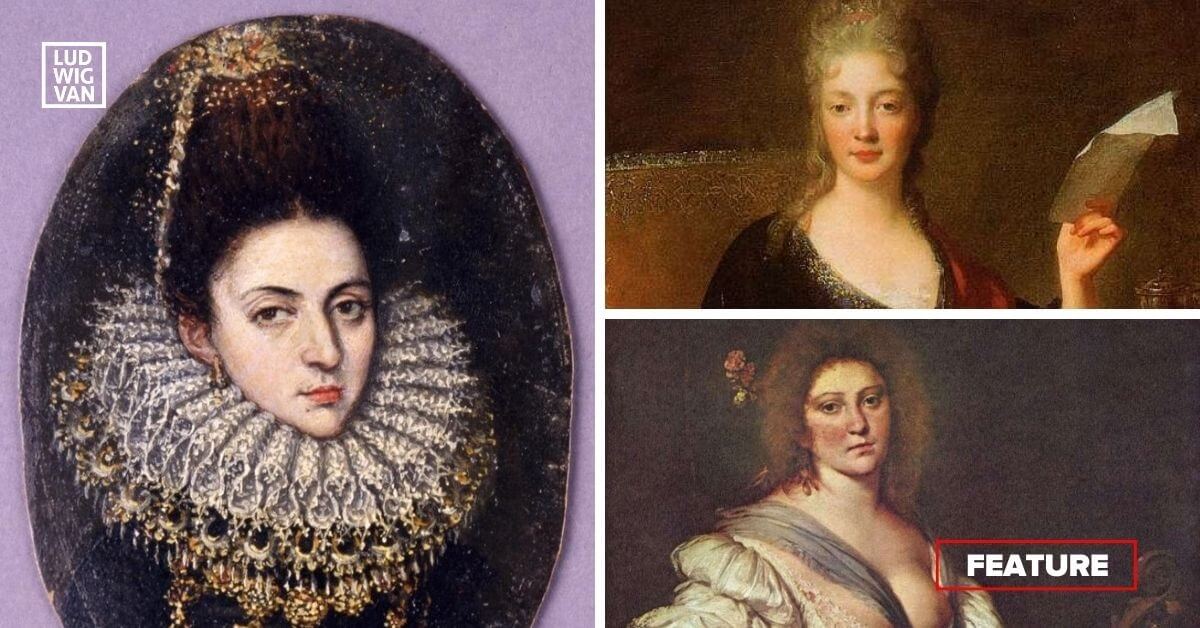
Going by representation in current repertoire, you’d be forgiven for mistakenly believing there were, in fact, no women composers during the Baroque era, covering about 1600 to 1750.
While it is certainly true that European society of that era did not encourage women to be anything other than wives and mothers, there were a surprising number who nonetheless managed to carve a notable career as composers and musicians in their own time.
Rich patrons and connections helped many to compose, and some even to publish, in an era where there was zero opportunity for women.
Wealth didn’t help, however, when their work was forgotten, sometimes for centuries, after their deaths. Just as the work of Joseph de Bologne and other Black composers was neglected by programmers until very recently, much of the music written by women has been lost to time.
Francesca Caccini (1587-1640)
Francesca Caccini, daughter of Renaissance composer Giulio Caccini, was influential in her era, but not much of her work survives today. She composed in a style that was innovative in her day, and helped to push music from the Renaissance into the early Baroque period. She is widely credited as the first woman composer to produce a full-length opera, the comedy-ballet titled La liberazione di Ruggiero dall’isola d’Alcina. It was performed for visiting royalty in 1625. She is recorded as having written more than 15 staged works, and “La Cecchina” as she was known, was also an accomplished vocalist, lutenist, teacher, and poet. She worked for the Medici family in Florence, and became the highest-paid musician at the Grand Duke’s court at one point.
Leonora Duarte (1610-1678 approx)
In 1641, English writer and diarist John Evelyn visited the home of the Duarte family in Antwerp. He wrote, “In the evening I was invited to Signor Duerts, a Portuguese by nation…and his three daughters, entertain’ d us with rare musick, both vocal and instrumental…” Leonora’s voice, in particular, was noted. The Duarte family were Portuguese Jews who had converted to Catholicism to avoid persecution, and Leonora’s father was a diamond merchant and amateur musician. The family home became a centre for musicians and artists in the city. Leonora composed music for the family’s performances for visiting dignitaries such as William Cavendish, Duke of Newcastle. Of all her works, a series of Sinfonia survive.
Barbara Strozzi (1619-1677)
In the mid-1600s, it was said that Barbara Strozzi was the most prolific composer of secular vocal music printed in Venice. Along with a single work of sacred songs, the secular material forms her body of work, much of it written for a soprano voice. Barbara was herself a highly regarded singer, and came from a creative family. Her adopted father was poet Giulio Strozzi, and she was regularly exposed to artists, writers, and musicians. Fellow Venetian composer Nicolò Fontei dubbed her la virtuossima cantatrice (that most virtuosic singer). She was born illegitimate, and did not marry. After her father’s death, she became a professional composer, and wrote eight volumes of work. One of her quirks was to often include a verbal pun on her own name in her cantatas and arias.
Isabella Leonarda (1620-1704)
Isabella Leonarda entered a convent at age 16, and never left, turning over her life to composition as well as teaching. She was one of the few women composers to write instrumental as well as vocal music. Her Sonatas, Op. 16 became the first known publication of instrumental sonatas by a woman in 1693. Isabella became an abbess, and one of the most prolific composers of the period. She is credited with more than 200 compositions, and served as a music instructor at the Collegio di Sant’Orsola, aconvent in Novara, where she also became Mother Superior. She had a prominent public profile in her time, and was written up in a directory of Novara’s VIPs.
Élisabeth Jacquet de la Guerre (1665-1729)
Born into a multi-generational family of harpsichord builders and organists, Élisabeth (or Lisbeth) Jacquet was a performing veteran by age five in the court of Louis XIV, the Sun King. In 1684, she married noted organizst Marin de la Guerre, and became a working musician, teacher, and composer in Paris. Élisabeth composed harpsichord suites, and was the first French woman to compose a full scale opera. She believed the words were as important as the music. In 1715, in the preface to a book of her Cantatas françoises, she wrote, “I am convinced that vocal music that does not express what one sings will not be favoured by … those whose taste and understanding go hand in hand.” In her time, she was considered second only to court composer Jean-Baptiste Lully.
#LUDWIGVAN
Get the daily arts news straight to your inbox.
Sign up for the Ludwig van Daily — classical music and opera in five minutes or less HERE.
- PREVIEW | SUMMER OPERA LYRIC THEATRE Presents Handel’s Xerxes, Mozart’s Idomeneo & Puccini’a La Boheme July 26 To August 4 - July 26, 2024
- PREVIEW | YENSA Festival V.2 Offers Black Flames Performances & Other Ways To Celebrate Black Women In Dance - July 25, 2024
- PREVIEW | Canadian Talent Conspicuous In The Met: Live In HD 2024-25 Season - July 25, 2024



